Chickens lay eggs in a variety of colors, including the familiar white and brown eggs we see in grocery stores and more exotic colors such as pink, blue, green, and even purple. Chicken eggshells are composed mainly of a material called calcium carbonate. This white, chalky-looking mineral is the default color of chicken eggs, but other colors may be added to the shell itself or on the outside of it, as the egg passes through the oviduct. Brown eggs are much more common than the eggs produced by the commercial egg industry might lead you to believe.
Here are 26 chicken breeds that lay brown eggs, in colors varying very light to dark, chocolatey, reddish, or purplish brown. Penedesenca, Marans, Welsummer, and Barnevelder chickens provide the darkest brown eggs on this list.
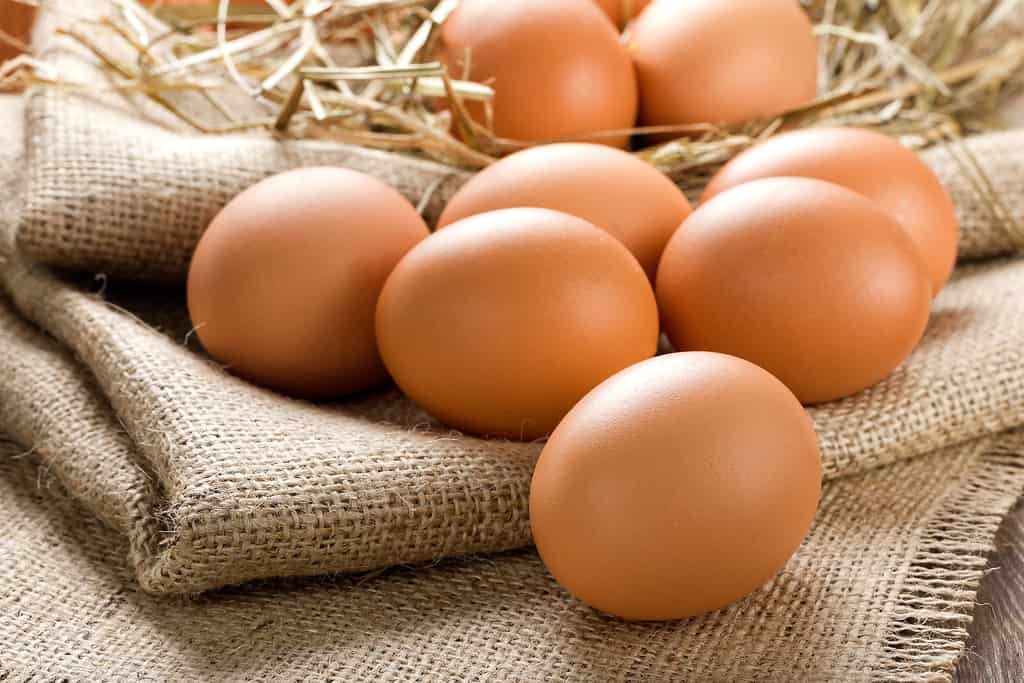
Many varieties of chickens lay beautiful brown eggs of different shades.
©Sea Wave/Shutterstock.com
Australorp Chicken
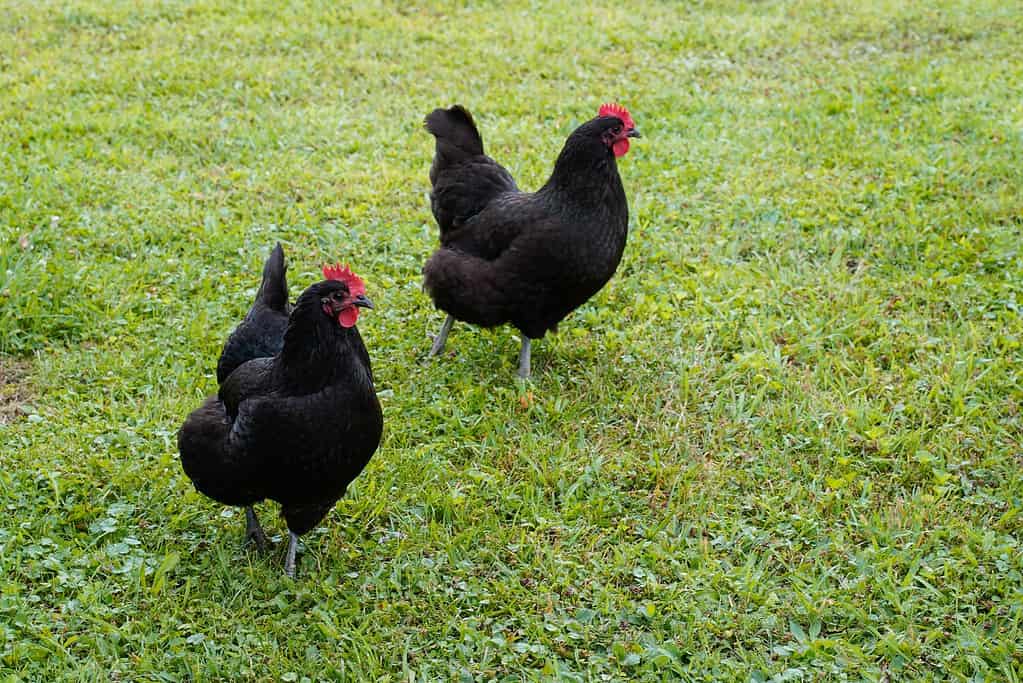
Australorp chickens, from Australia, came from crosses with Orpingtons and other chickens.
©Kathy D. Reasor/Shutterstock.com
The Australorp chicken lays medium-sized, light brown eggs with a pink tinge. Hens produce about 4 to 5 eggs per week.
Australorp chickens once held multiple world records for egg production. One hen laid 364 eggs in a single year. The Australorp, bred in Australia from Black Orpington chickens and other breeds, was at the time one of the most popular chickens in the world. Breeders had the single goal of increasing egg production to the greatest extent possible.
In Australia, in the 1920s, Australorp hens set one world record after another. Demand exploded and they were exported to several countries. Sadly, they did not produce nearly as well in other parts of the world, so their popularity began to quickly fade. Although Australorp chickens do not rule the egg industry as hoped, they are still among the best egg producers, averaging about 250 to 300 eggs each year at their peak.
Barnevelder Chicken
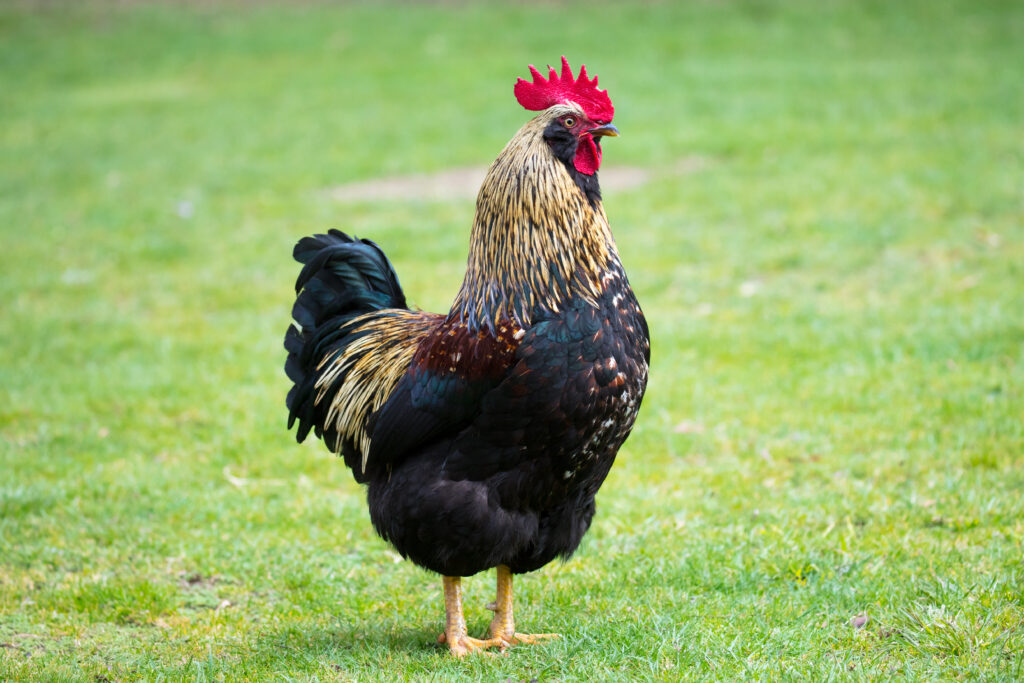
The Barnevelder chicken originated in the Netherlands in the early 1900s.
©FiledIMAGE/Shutterstock.com
The Barnevelder chicken is among the few chickens that lay large, dark brown eggs that sometimes come out speckled. Hens produce between 3 to 4 eggs per week.
Barnevelder chickens arose from the Netherlands around the turn of the 20th century. Bred from crosses with Asian chickens and a number of other breeds, the Barnevelder was recognized by the Dutch Poultry Society in 1923. These birds show significant sexual dimorphism, with the hens showing feather patterns that barely resemble the roosters. Six different color patterns are recognized in Europe, but the American Poultry Association (APA) recognizes only the partridge variety. Barnevelders are best known for their deep, chocolate-brown eggs that sometimes have speckles.
Brahma Chicken
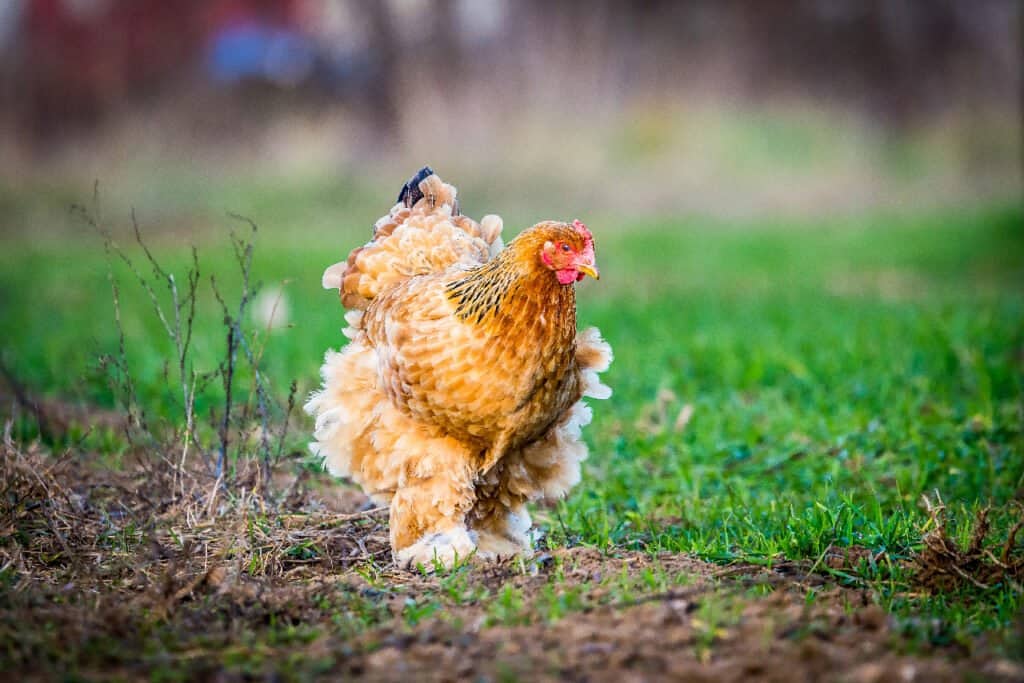
Brahma chickens rank among the heaviest of all chickens.
©Adrian Eugen Ciobaniuc/Shutterstock.com
The Brahma chicken lays medium to large size, medium brown eggs. Hens produce around 3 to 4 eggs per week.
Brahma chickens, sometimes called the King of all Poultry, originated in the United States in the 1840s. Breeders combined such birds as Cochin chickens, Malay chickens, and Chittagong fowl imported from India. Brahma chickens rank as one of the world’s largest chickens, by both height and weight. They weigh between 8 and 12 pounds, but they look even larger thanks to their dense, fluffy feathers. Brahma chickens are called gentle giants because they are usually friendly and easy to handle.
Chantecler Chicken
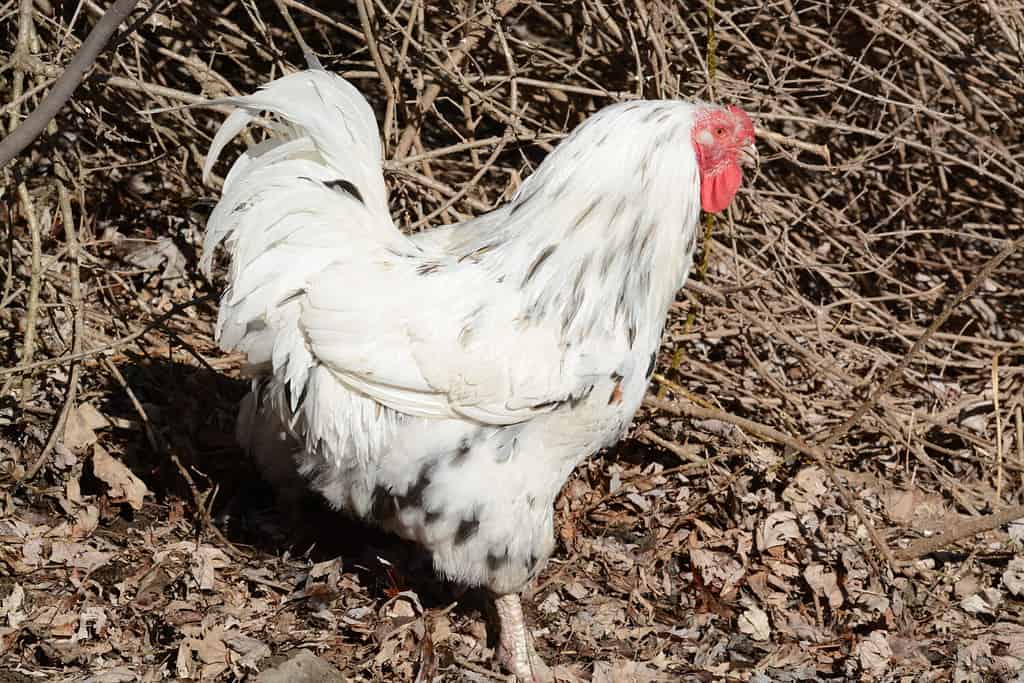
Chantecler chickens, a Canadian breed, can withstand harsh winter weather with ease.
©Pat Stornebrink/Shutterstock.com
The Chantecler chicken lays large, light brown eggs with a pink tinge. Hens produce about 3 to 4 eggs per week.
A monk from Canada, Brother Chatelain, created the breed after noticing that the flock at an abbey in Quebec had no Canadian chickens. He developed the Chantecler chicken with cold hardiness in mind. Crossing large, hardy breeds such as Cornish chickens, white Leghorns, Rhode Island Reds, and white Wyandotte chickens, Brother Chatelain approached the bird he sought to create. He achieved success with the pure white Chantecler chicken after completing a final cross with white Plymouth Rocks.
The APA recognized the white Chantecler chicken in 1921, followed by the partridge variety in 1935. Chantecler chickens have features that help them thrive in cold climates and resist frostbite, including full feathers, very small, cushion combs, and practically no wattles.
Cochin Chicken
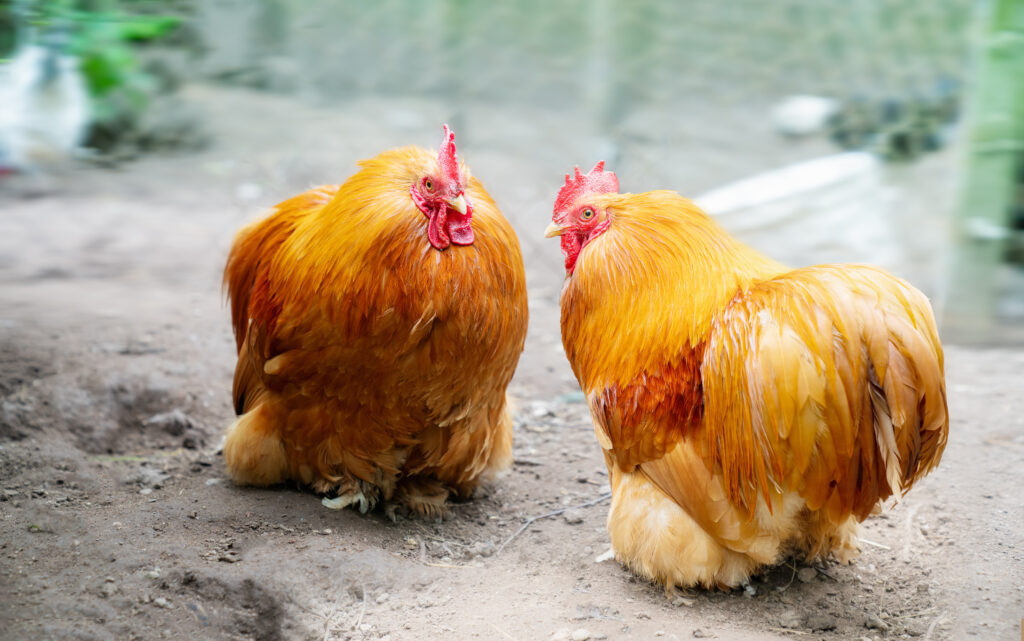
Cochin chickens, though very large, are calm and exceptionally friendly.
©Algirdas Gelazius/Shutterstock.com
The Cochin chicken lays medium to large size, light to medium brown eggs. Hens produce approximately 2 to 3 eggs per week.
This huge, fluffy breed resembles a heart-shaped ball. They have abundant feathers all the way down their feet. Cochin chickens sparked the phenomenon known as hen fever when Queen Victoria fell in love with them after receiving a small flock as a gift. She enjoyed sitting in a special aviary built just for her prized chickens, and of course, everyone who could afford to buy Cochin chickens followed her lead. The price of this breed soared until the overinflated poultry market crashed. Today, many owners keep Cochin chickens as exhibition birds. The APA recognizes these hardy chickens in large and bantam sizes, and in 17 colors.
Cornish Chicken
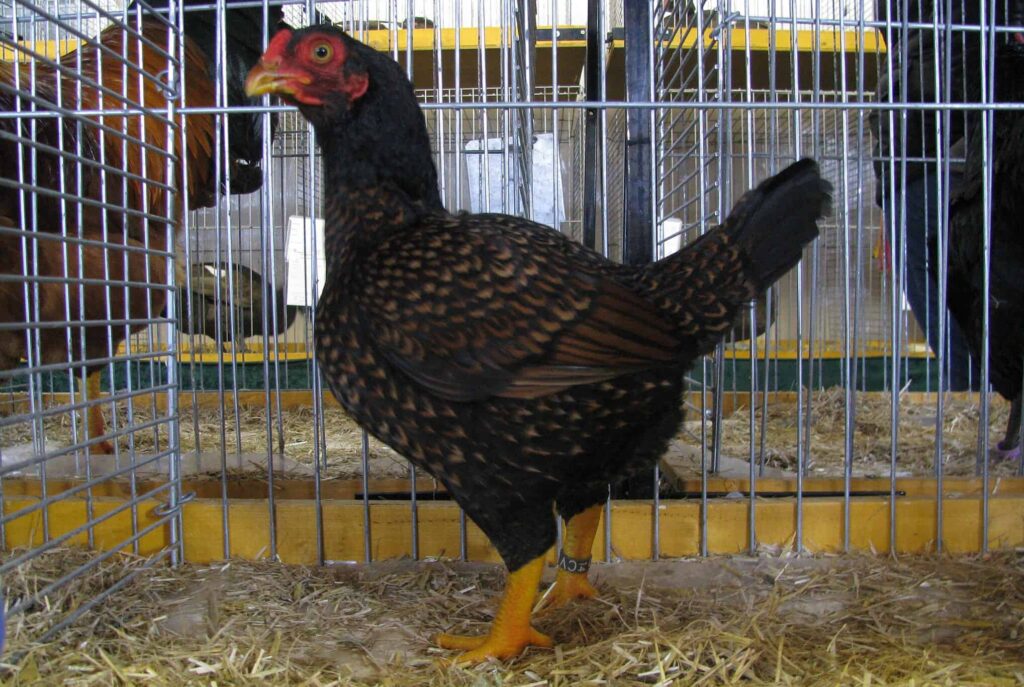
Cornish chickens, also known as Indian Game chickens, lacked promise as fighting birds.
©RGZV Frankenthal / CC BY 3.0 – License
The Cornish chicken lays small, light to medium brown eggs. Hens do not produce well, laying just 1 to 2 eggs per week.
Cornish chickens have struggled to find their niche since they were first developed around 1820 in England. The Cornish chicken, originally known as the Indian Game chicken, was designed to be an ultimate fighting breed. The experiment failed, yielding a bird that was neither a great fighter nor a decent farm bird. It laid few eggs, produced insufficient meat, and fared poorly in cold weather. But the bird did grow quickly, allowing for the harvest of the tender and meaty dinnertime favorite, Cornish game hens.
Delaware Chicken
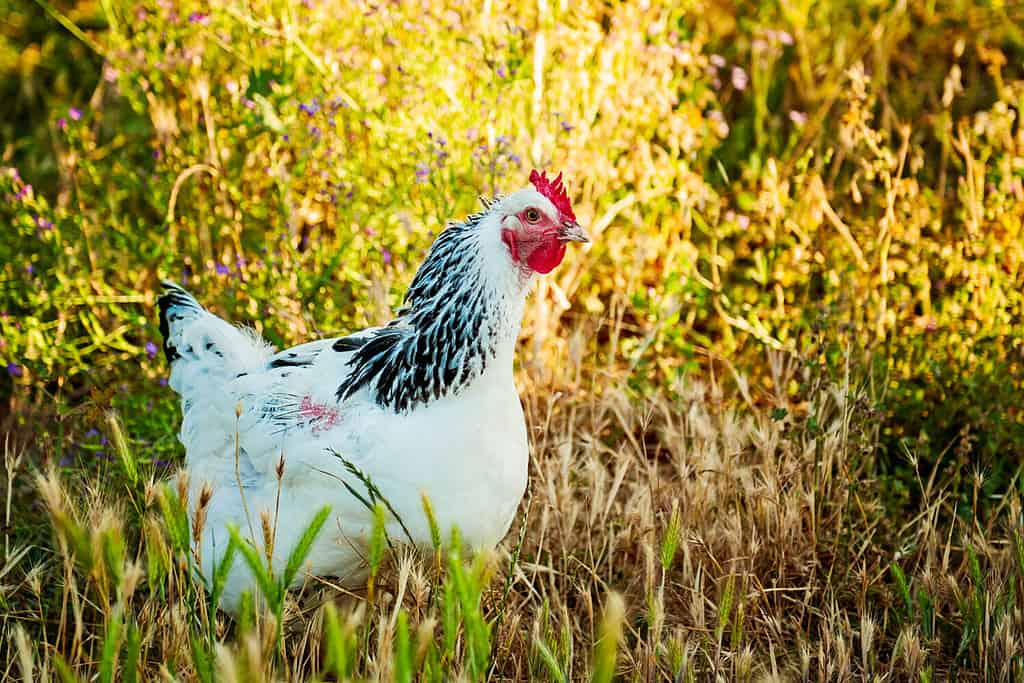
Delaware chickens, first bred in the 1940s, became very popular for about 15 to 20 years.
©Horse Crazy/Shutterstock.com
The Delaware chicken is an American breed that lays extra-large, light-brown eggs. Hens produce about 4 eggs per week on average.
This breed originated in the state of Delaware, in the United States, in the 1940s. It resulted from crosses made between Plymouth Rock roosters and New Hampshire hens. Some offspring had uniquely barred feather patterns that breeder, George Ellis, sought to develop. The APA recognizes only one variety of Delaware chicken.
Dominique Chicken
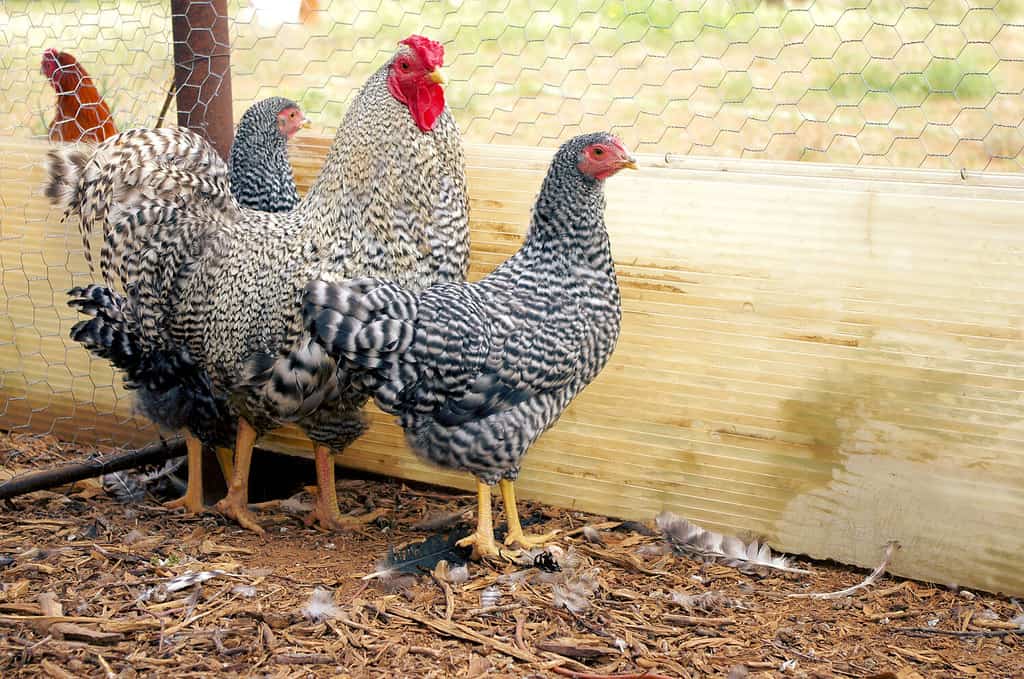
Dominique chickens feature a recognizable black-and-white barred pattern.
©The Jungle Explorer/Shutterstock.com
The Dominique chicken lays medium-sized, light brown eggs. Hens produce approximately 4 to 5 eggs per week.
Dominique chickens made their way to America during the colonial period, at least as early as the 1750s. They are known as America’s first chicken breed. These beautifully barred birds may have come by way of England with the pilgrims, or possibly from French settlers on the island of Haiti, formerly known as Saint Dominique. Featured in the first poultry show in the United States in 1849, Dominique chickens suffered a great decline by the end of World War II. They neared extinction by the 1970s, but thanks to concerted efforts, the Livestock Conservancy currently notes that their numbers are stable.
Faverolles Chicken
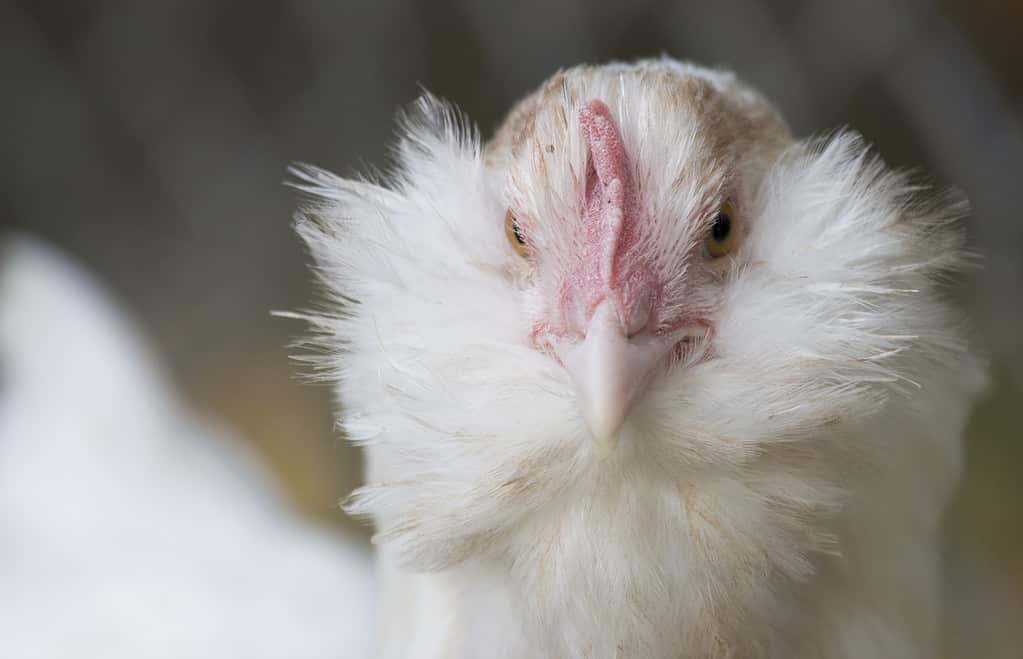
Faverolles chickens, even the hens, sport full, feathery beards.
©JZHunt/iStock via Getty Images
The Faverolles chicken from France lays medium-sized, light-brown eggs. Hens produce about 4 eggs per week.
Faverolles chickens are the product of extensive cross-breeding. Breeders invested years crossing several different types of chickens, before developing the Faverolles around 1886. This medium-sized breed features round, fluffy bodies and full, feathered beards. Breeders throughout Europe and the United States favor Faverolles for their year-round egg production. The APA recognizes this breed in white and unique salmon varieties.
Jersey Giant Chicken
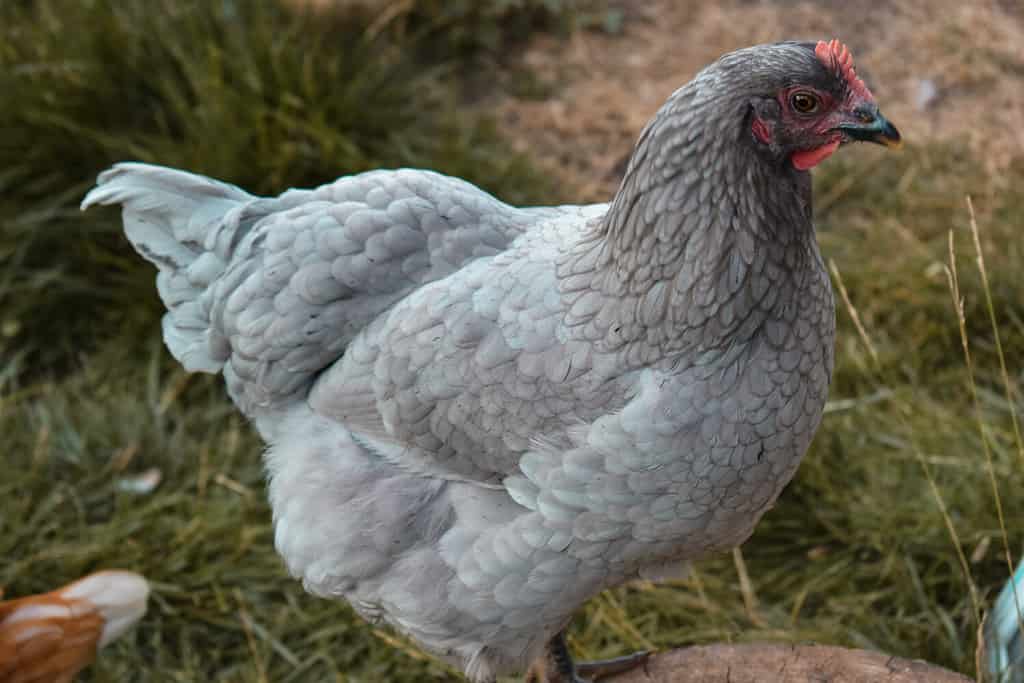
Jersey Giant chickens, one of the largest breeds, come in black, white, and blue variations.
©Finnegan’s Fotos/Shutterstock.com
The enormous Jersey Giant chicken is one of the chickens that lay large eggs that vary in color from very light to dark brown. Hens produce approximately 2 to 4 eggs per week.
The Jersey Giant chicken was developed with only size in mind. John and Thomas Black of New Jersey combined several large chickens to create the breed between 1870 and 1890. The result of their efforts was indeed a huge bird. Jersey Giant roosters weigh between 13 and 15 pounds, and hens weigh 10 to 11 pounds. Jersey Giant hens outweigh the roosters of most other breeds. The APA recognizes this breed in black, white, and blue varieties.
Langshan Chicken
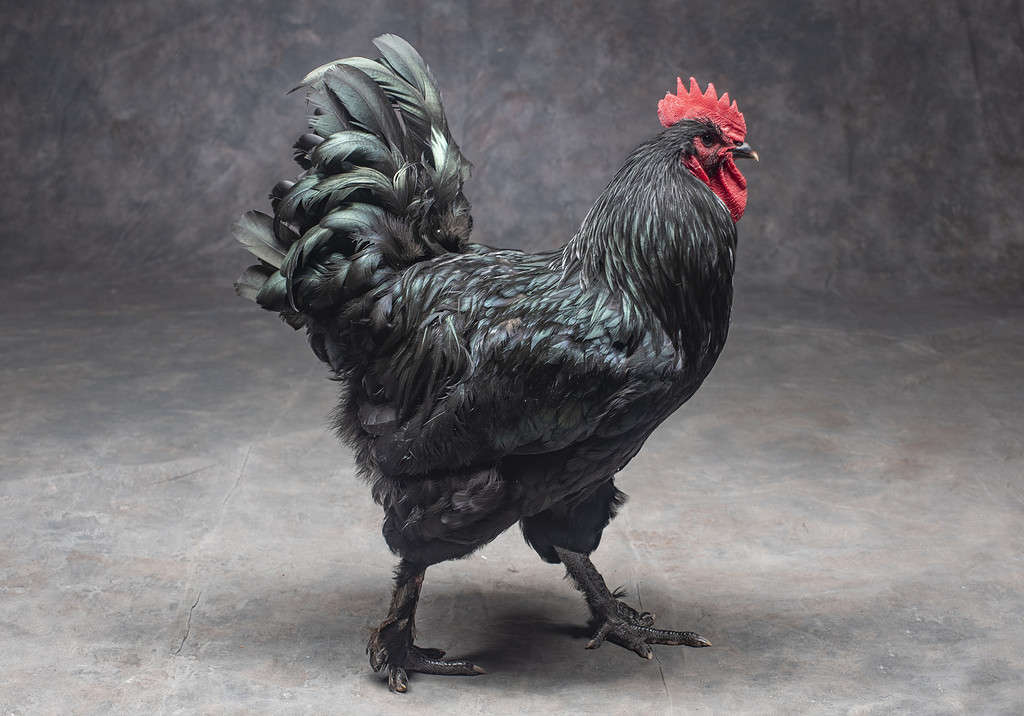
Black Langshan chickens have glossy black feathers with a green sheen.
©John Touscany/iStock via Getty Images
The Langshan chicken is one of the only chickens that lay purplish brown eggs. They lay large eggs with a medium to dark brown color which sometimes have such a prominent purple tint, that people describe their color as plum. Hens produce an average of 3 to 4 eggs per week.
Langshan chickens originated in the Langshan area of China and were exported to England in 1872. This breed is sometimes called the Croad Langshan, after the English officer, Major A. C. Croad, who originally exported them. The breed quickly spread over Europe and to Australia and the United States. The APA recognizes only three colors of Langshan chickens, including black, white, and blue, in both bantam and large varieties.
Malay Chicken
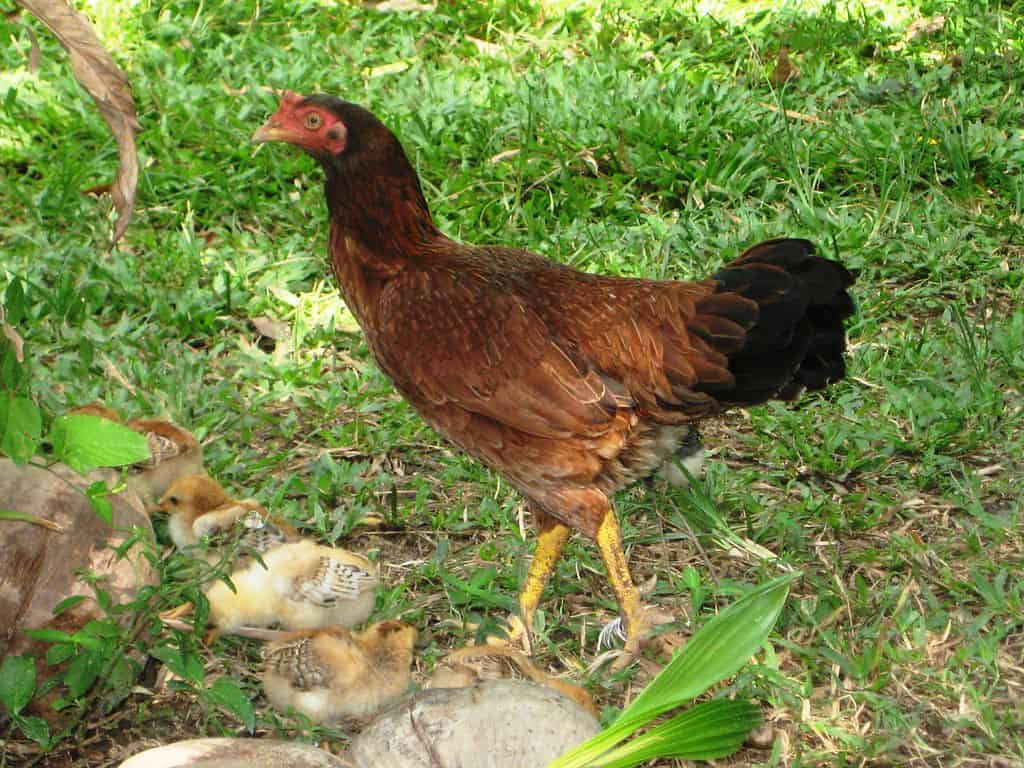
Malay chickens rank among the tallest chickens, reaching heights of up to 30 inches.
©Zamwan, CC BY-SA 3.0 <https://creativecommons.org/licenses/by-sa/3.0>, via Wikimedia Commons – License
The Malay chicken lays medium-sized, medium-brown eggs. Hens produce only about 1 to 2 per week at most.
Malay chickens, among the tallest in the world, originated in India or southeast Asia, around Malaysia, long ago. This breed can reach up to 36 inches in height. Malay chickens have served as predecessors to many modern breeds. Breeders imported Malay chickens to Europe by the early 1800s, and by 1846 the breed made it to the United States. The APA recognizes Malay chickens in six colors. The Livestock Conservancy currently lists the Malay chicken as critical. Only a few flocks remain in the world and no breeders currently offer chicks.
Marans Chicken
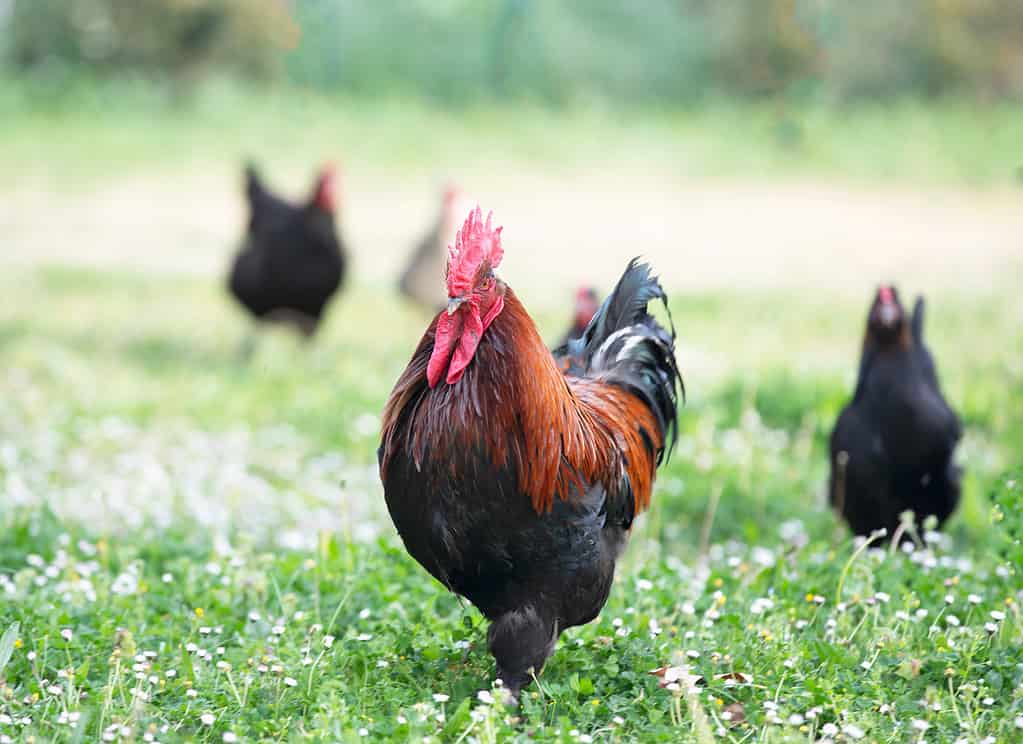
Marans chickens originated in France and are famous for their dark brown eggs.
©cynoclub/Shutterstock.com
The Marans chicken lays large, dark chocolatey brown eggs, sometimes adorned with speckles. Hens produce around 3 to 4 eggs per week.
Marans chickens are prized for laying some of the darkest, richest brown eggs in the poultry world. These eggs found fame in From Russia with Love. They were the only eggs James Bond preferred. Marans chickens, named after the town of Marans in France where they originated, had their first showing in France in 1914. The APA did not recognize the Marans chicken until nearly a century later, in 2011, when they at last accepted the black copper variety. The APA added the white, wheaten, and black varieties to the Standard of Perfection in 2021.
Naked Neck Chicken
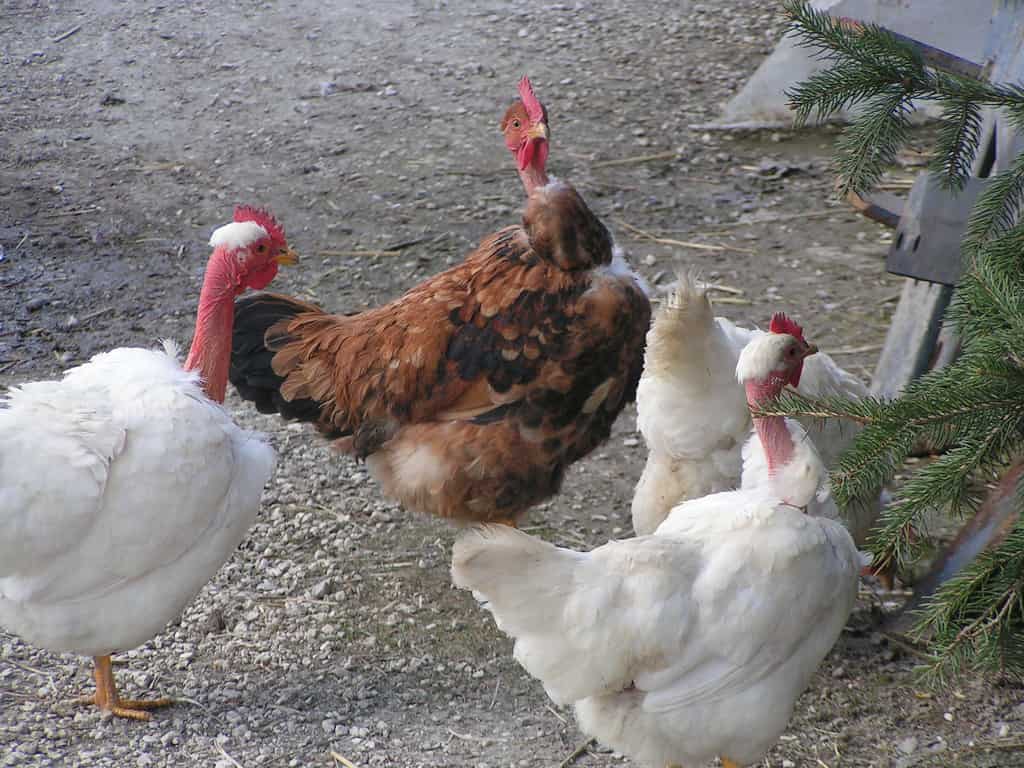
Naked Neck chickens, also known as Turkens, originated in Transylvania.
©Simone Ramella / CC BY 2.0 – License
The Naked Neck chicken lays medium to large size, light brown eggs. Hens produce approximately 3 to 4 eggs per week.
The Naked Neck chicken, named for its bare, featherless neck, likely originated in Asia. Also known as the Transylvanian Naked Neck, it grew in popularity after its introduction to Romania in the late 1800s. This odd-looking bird, sometimes called a Turken, might resemble a cross between a chicken and a turkey, but it is all chicken. Besides their naked necks, these birds have sparse feathers all over and really cannot fly. A single gene causes their odd feathering, and the trait can be introduced to other breeds. The APA recognizes four colors of Naked Neck chickens, including white.
New Hampshire Chicken
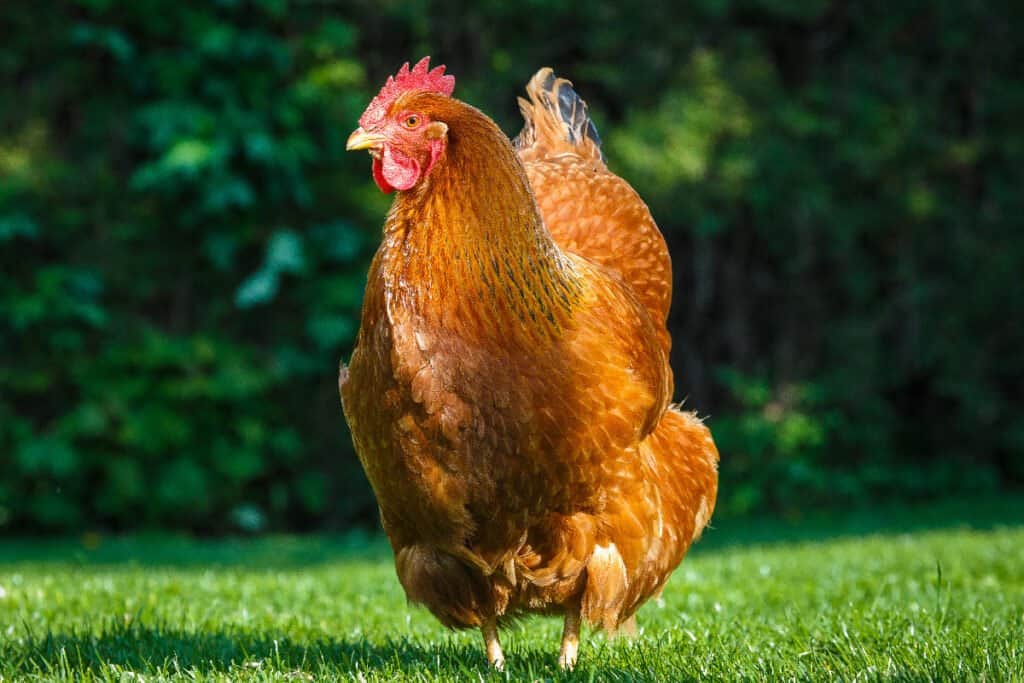
New Hampshire chickens descended solely from the Rhode Island Red chicken.
©Jesper Frehr/Shutterstock.com
The New Hampshire chicken lays large, light brown eggs. Hens produce roughly 3 to 4 eggs per week.
New Hampshire chickens developed as a result of selective breeding of the Rhode Island Red chicken. Breeders in New Hampshire and Massachusetts sought to create a new breed that would grow and mature faster than its predecessor. They succeeded, and the APA recognized the New Hampshire chicken in 1935. This breed helped develop the broiler industry, which provided much-needed meat to the country during and after World War II.
Onagadori Chicken
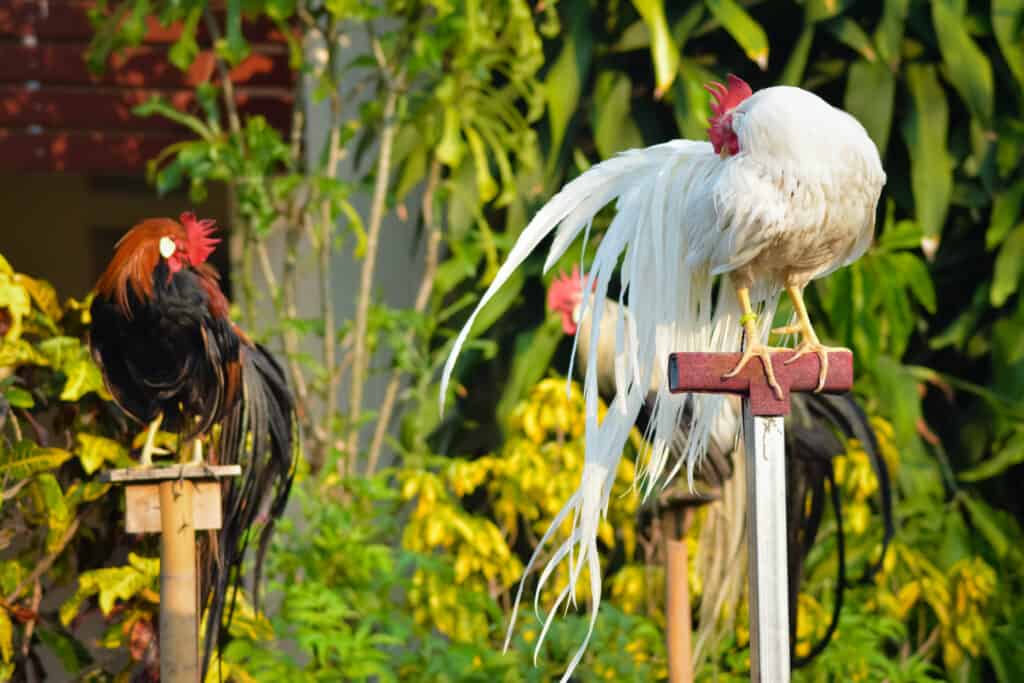
The ornamental Onagadori chicken originated centuries ago in the Kochi Prefecture in Japan.
©SARAWUT DEEPALA/Shutterstock.com
The Onagadori chicken lays medium size, very light brown eggs. Hens lay about 1 egg per week at most.
Onagadori chickens originated in the Kōchi Prefecture of Japan. They were declared a Japanese National Natural Treasure in 1952. Known for their extremely long tails, owners selectively bred these chickens to preserve a mutation that prevented their tail feathers from molting. As a result, Onagadori tails can grow up to 27 feet in length. Keeping birds with such an unusual trait is a challenge. Few have survived, and the breed is considered endangered.
Orpington Chicken
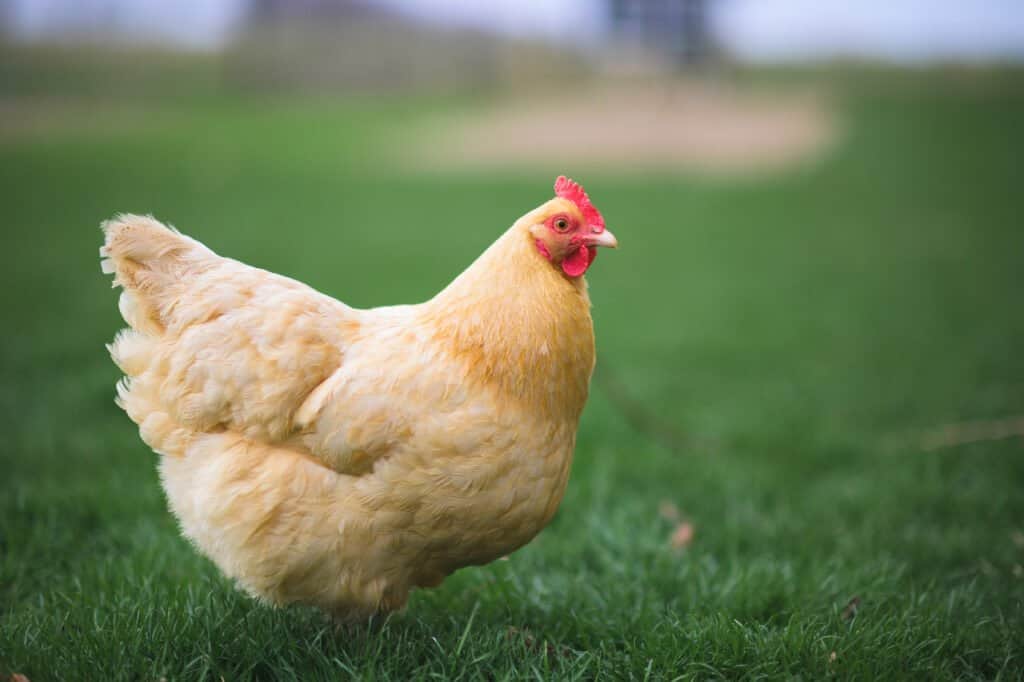
Orpington chickens come in multiple colors, but the Buff Orpington ranks highest in popularity.
©Tyler T. Photography/Shutterstock.com
The Orpington chicken lays large, light brown eggs. Hens produce up to 4 to 5 eggs per week.
The extremely fluffy Orpington chicken originated in the town of Orpington in England in 1886. This breed came from crosses between Plymouth Rock chickens from the United States, Langshan chickens from Asia, and Minorcas chickens from Spain. Decades ago, Orpington chickens ranked among the world’s best egg producers. Hens sometimes produce up to 340 eggs per year, but today they average fewer than 200. The APA recognizes four colors in both large and bantam sizes, including white, black, blue, and buff. Buff Orpington chickens are the most popular among the various colors.
Penedesenca Chicken
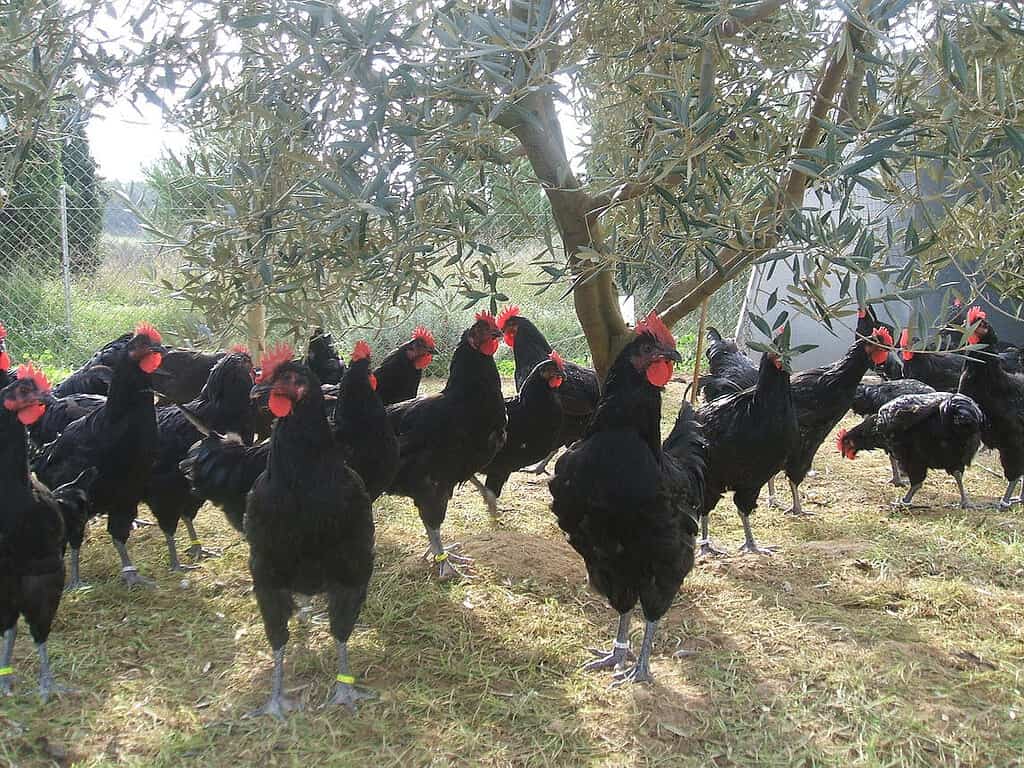
Penedesenca chickens lay some of the darkest reddish-brown eggs in the poultry world.
©Maria Antònia Udina Castell / CC BY-SA 3.0 – License
The Penedesenca chicken lays medium to large, dark brown eggs. Hens produce an average of 3 to 4 eggs per week.
Penedesenca chickens originated in Spain, in the Penedès region of Catalonia. The time of their development is unknown, as the first official records of their existence arose in the 1920s when breeders began making an effort to save them. As a local breed, they likely existed for quite a while, but by that time imported breeds had taken priority. If not for their exceptionally dark eggs, perhaps the darkest reddish-brown in the poultry world, the Penedesenca may have gone extinct. Fortunately, people saw their value and today small flocks exist in several countries, including the United States. The APA currently has not recognized this breed.
Phoenix Chicken
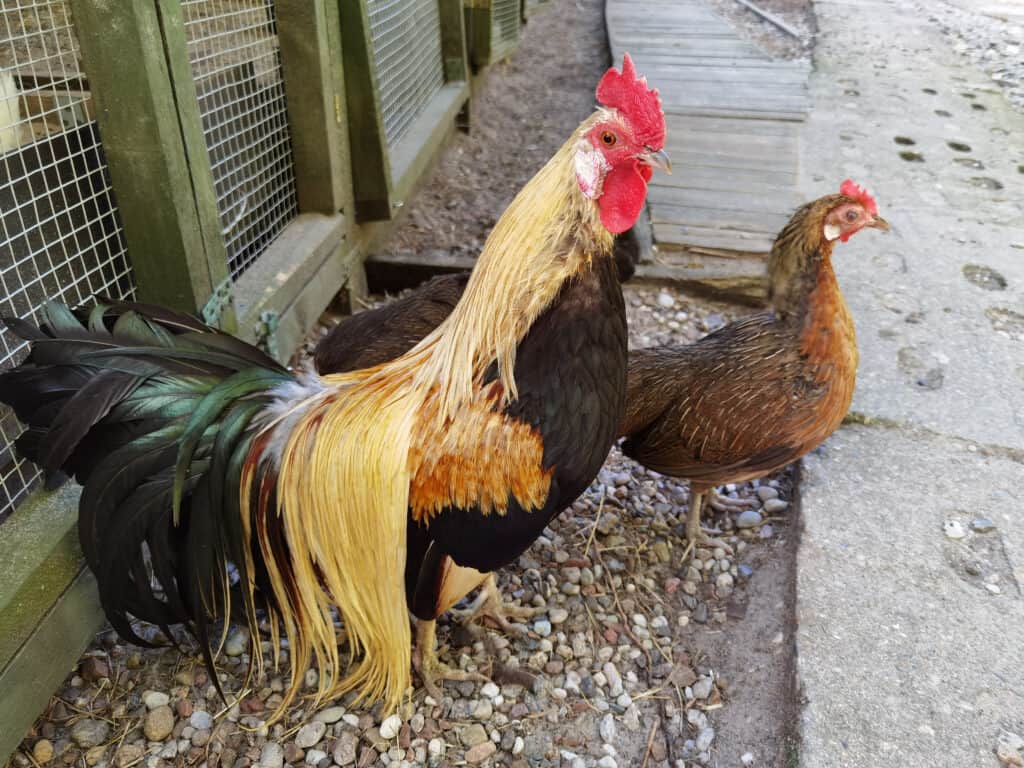
Phoenix chickens, developed in Germany, descended from the Onagadori chicken.
©Kabar/Shutterstock.com
The Phoenix chicken lays small to medium-sized, very light brown to cream-colored eggs. Hens only produce between 1 to 2 eggs per week at most.
Phoenix chickens originated in Germany in the late 19th century. The small and graceful Phoenix chicken was the product of selective breeding. It combined traits from hardy European chickens and historic Japanese chickens, including the impressive Onagadori which boasts tail feathers up to 27 feet long. The breed proved better able to withstand cold weather but still required special care. Phoenix chickens are not good layers and are not great for meat, either, but they are prized around the world for their beauty. These ornamental birds make a glorious addition to any backyard flock with their silver, golden, and copper hues and their long tail feathers measuring up to five feet in length.
Plymouth Rock Chicken
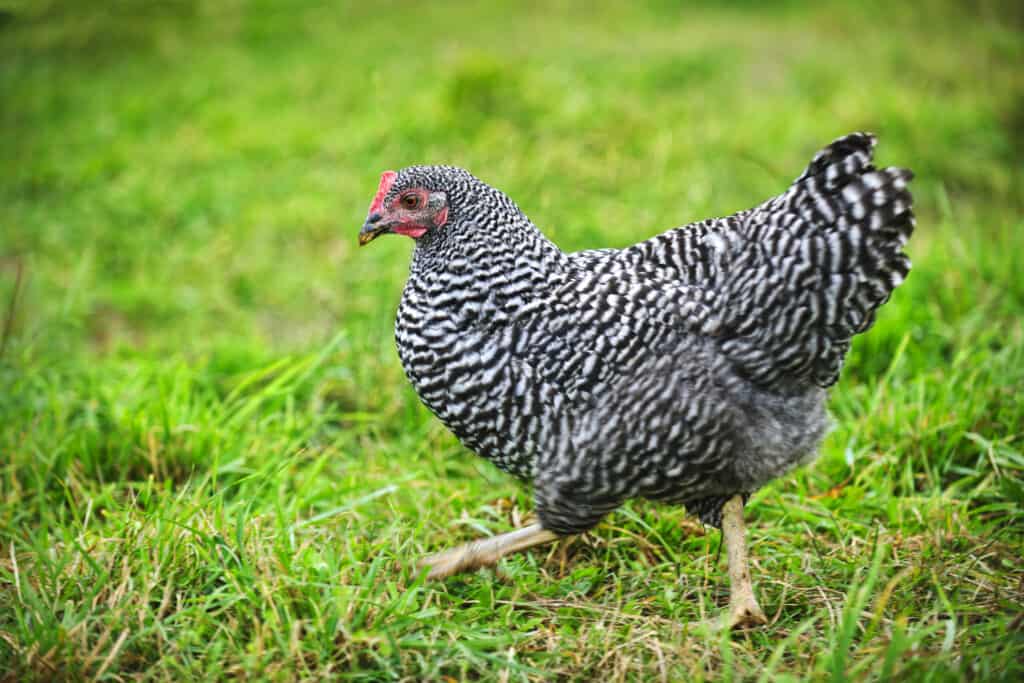
Plymouth Rock chickens come in a variety of colors, including Barred Rocks which have a barred pattern.
©iStock.com/Elenathewise
The Plymouth Rock chicken lays large, medium-brown eggs. Hens produce approximately 4 to 5 eggs per week.
Plymouth Rock chickens made their debut at a poultry show in Massachusetts in 1849. They disappeared briefly but then resurfaced 20 years later and went on to become a popular dual-purpose bird. The APA recognizes seven different colors in the large variety and eight colors in the bantam variety. The barred variation, often called the Barred Rock, covered head to tail in feathers with narrow black and white bars, is by far the most popular of all the colors.
Rhode Island Red Chicken
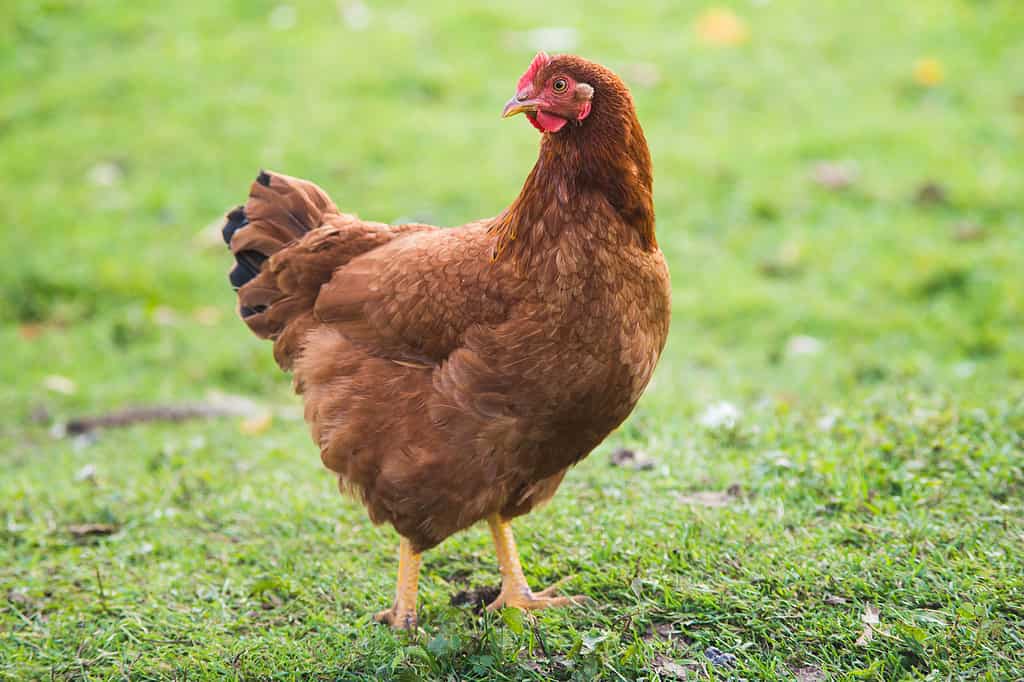
Rhode Island Red chickens are among the longest-living chicken breeds.
©Nadanka/iStock via Getty Images
The Rhode Island Red chicken is among the chickens that lay the most brown eggs. Its eggs are large and light brown. Hens produce up to 4 to 6 eggs per week.
Rhode Island Red chickens originated, as one might expect, in Rhode Island in 1854. A sea captain brought home a Malay chicken from a voyage and bred it with the chickens he had at home. Noticing that the offspring produced many more eggs, he and a friend began cross-breeding with several other breeds to get the qualities they desired. The result became known as the Rhode Island Red, one of the best dual-purpose birds ever bred in the United States. It spread all over the world and helped create a wide variety of hybrid breeds.
Rhode Island White Chicken
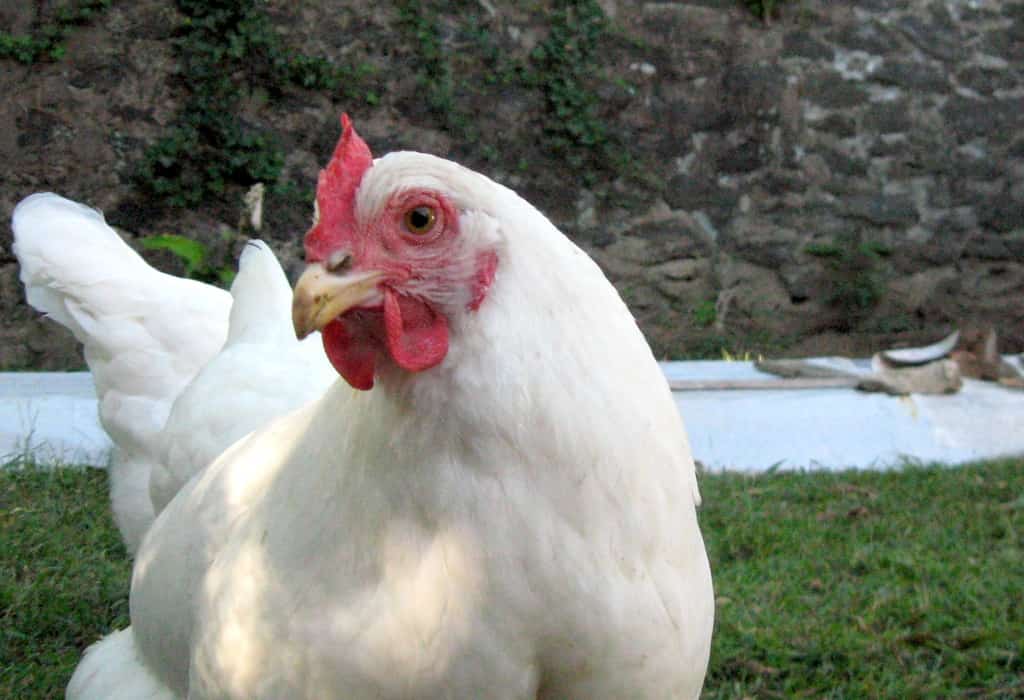
Rhode Island White chickens are a completely different breed than Rhode Island Reds.
©Steven Johnson from Philadelphia / CC BY 2.0 – License
The Rhode Island White chicken lays large, light to dark brown eggs, Hens produce approximately 4 to 5 eggs per week.
Rhode Island White chickens are not simply a white variation of the Rhode Island Red chickens, although they both arose from Rhode Island. They have separate lineages and are not very closely related, even though they have a similar overall shape. Sometime around the turn of the 20th century breeders combined Cochin chickens, white Wyandotte chickens, and white Leghorns to create the Rhode Island White. The APA added the breed to its Standard of Perfection in 1922.
Shamo Chicken
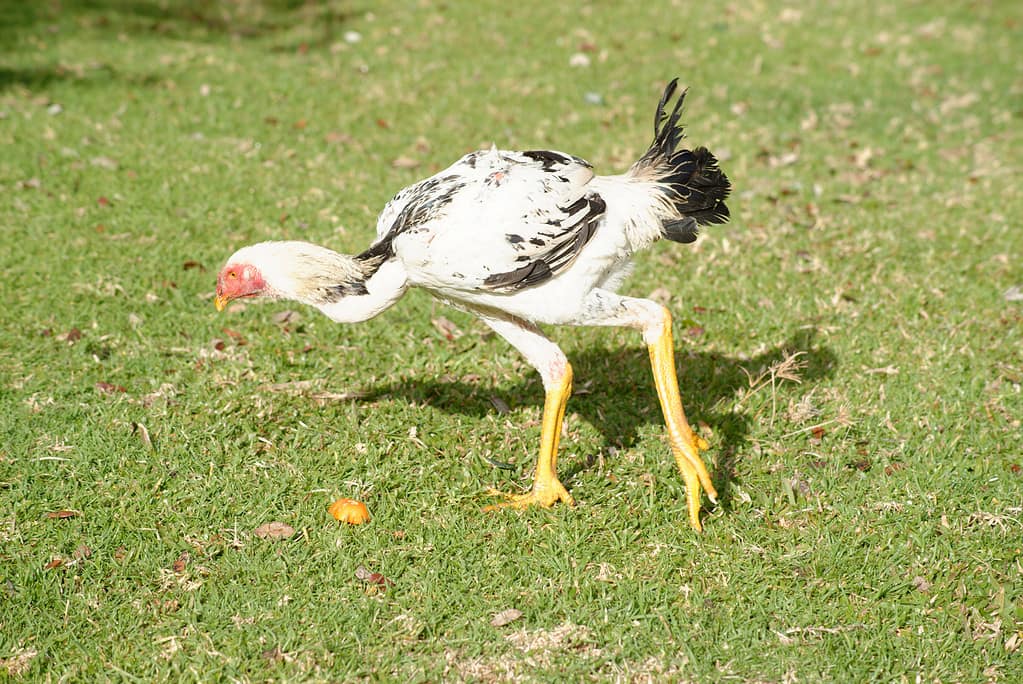
Shamo chickens, game birds from Japan, were imported to the United States after World War II.
©Wirestock/iStock via Getty Images
The Shamo chicken lays medium to large size, light-brown eggs. Hens produce only about 1 to 2 eggs per week.
Shamo chickens arrived in Japan roughly 400 years ago. These fighting birds were developed in India and Pakistan before they were taken to the land of Siam, currently known as Thailand. Like other game birds, the Shamo chicken has a large and lanky form, reaching heights of up to 30 inches. But breeders were never selected for egg production. Although the Shamo chicken is closely related to the Aseel chicken, the APA recognized the breed and added it to the Standard of Perfection in 1981. Currently, recognized colors include black, black-breasted red, dark, and wheaten.
Sussex Chicken
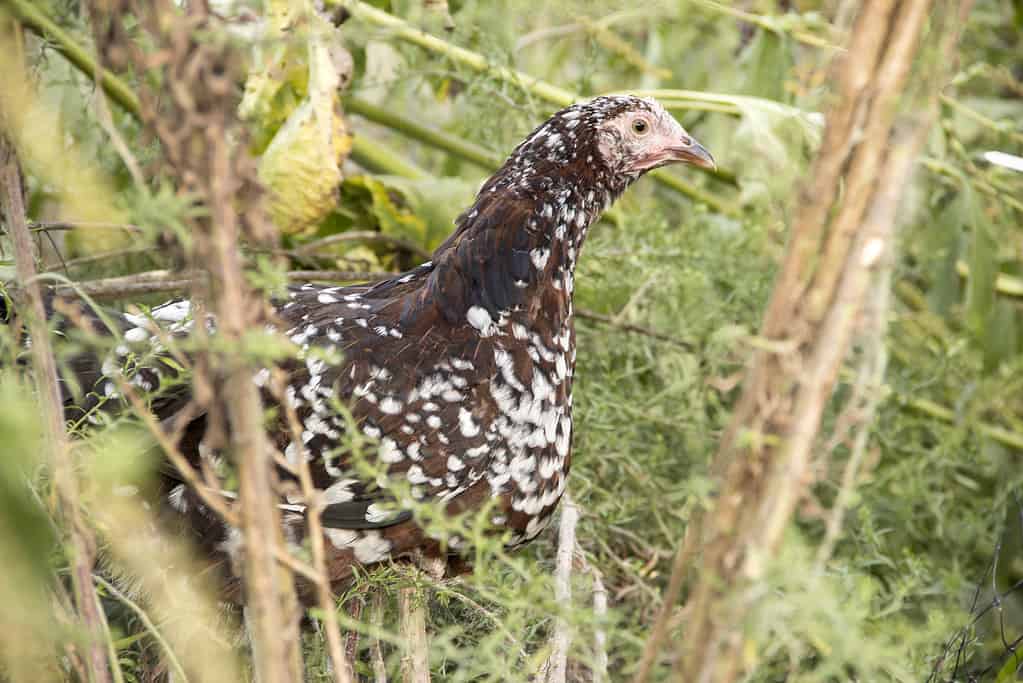
Speckled Sussex chickens bear the closest resemblance to their ancestral form.
©JZHunt/iStock via Getty Images
The Sussex chicken lays large, light brown eggs. Hens produce about 4 to 5 eggs per week.
Sussex chickens are one of Britain’s oldest domestic breeds. Their history extends back more than 2,000 years. The Sussex chicken that we know today is descended from a landrace bird that lived in the Sussex area of southeast England before the Romans invaded Britain in 43 A.D. During the hen fever period of the 19th century, breeders crossed the Sussex chicken with various Asian birds. The offspring grew larger and more impressive, but they had poorer meat quality and larger bones. Eventually, concerned breeders worked to restore the breed to its original form. Today’s Sussex chicken, especially the speckled variety, closely resembles its ancestral breed.
Welsummer Chicken
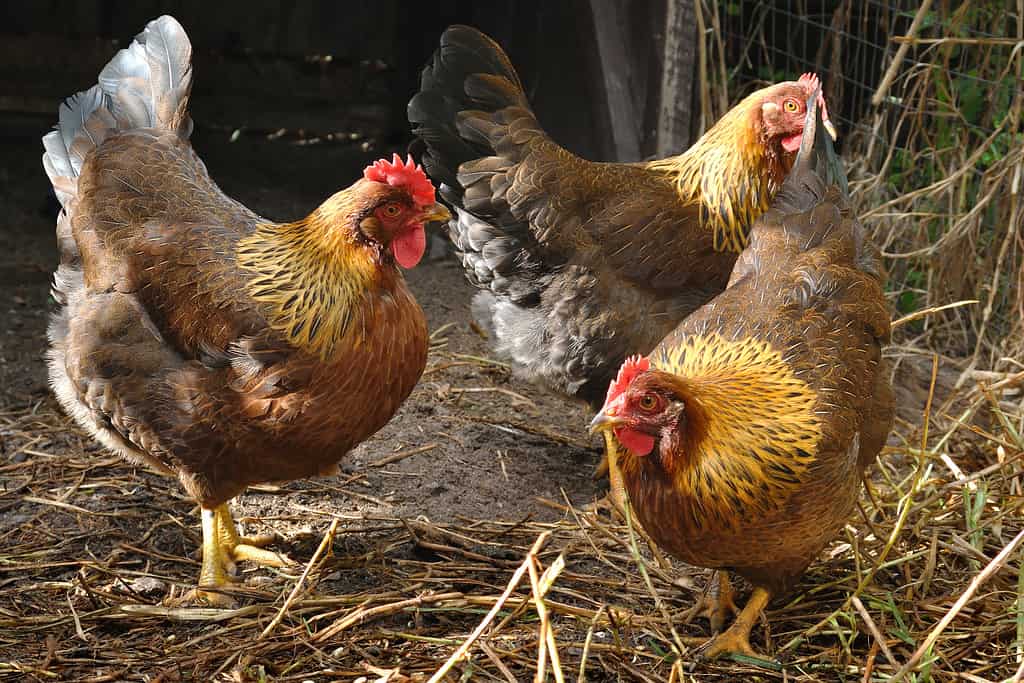
Welsummer chickens, with their golden hoods, originated in the Netherlands in the 1920s.
©illarionovdv/iStock via Getty Images
The Welsummer chicken is one of the breeds that lay the darkest brown eggs. It lays large, dark brown eggs that sometimes come out speckled. Hens produce an average of 3 to 4 eggs per week.
Welsummer chickens originated in the Netherlands around a century ago. Named after the Dutch village of Welsum where the breed first appeared, the Welsummer chicken has traits from several older breeds. According to the Poultry Club of Great Britain, the Welsummer descended from “such breeds as the partridge Cochin, partridge Wyandotte, and partridge Leghorn, and still later the Barnevelder and the Rhode Island Red.” You may find the Welsummer rooster quite familiar. This breed was the model for the rooster on the box of Kellogg’s Corn Flakes. Hens, though not as vibrantly patterned, are equally beautiful.
Wyandotte Chicken
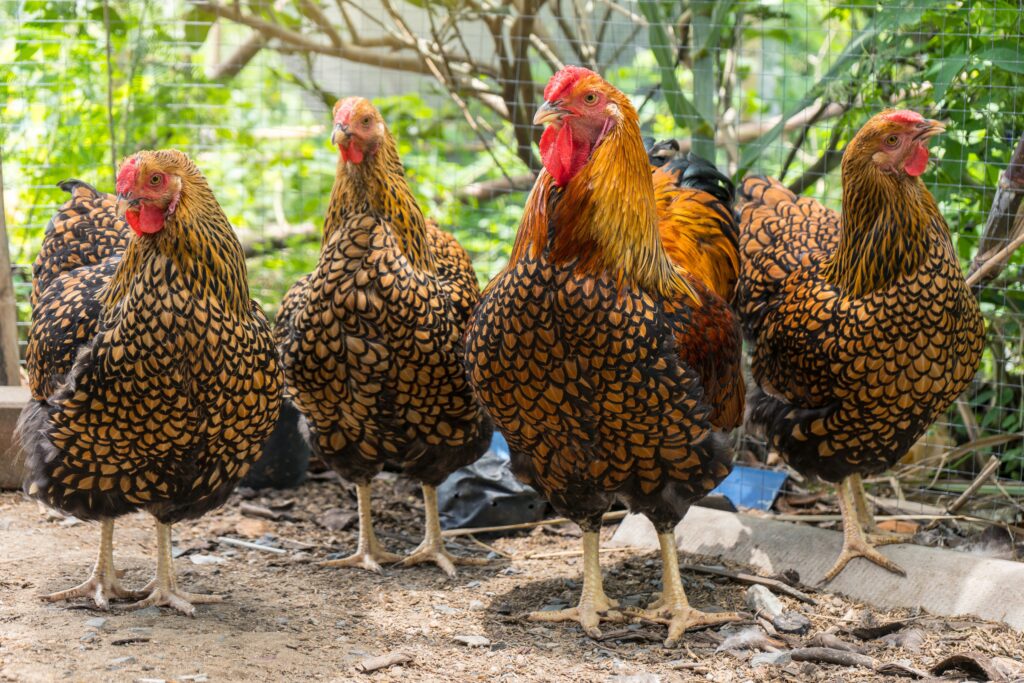
Wyandotte chickens come in several colors and patterns, including the gorgeous golden-laced variety.
©Ton Bangkeaw/Shutterstock.com
The Wyandotte chicken lays medium-sized, light-brown eggs. Hens produce roughly 4 eggs per week.
Wyandotte chickens are an American breed. They were developed by breeders in New York, Michigan, and Massachusetts in the 1870s. This breed proved to be an extremely hardy dual-purpose chicken. Wyandotte chickens gained popularity quickly in the United States and Canada, and exporters spread the breed throughout Europe, Australia, and parts of Africa. Contrary to popular belief, Wyandotte chickens were reportedly named after a ship, not the Native American tribe of the same name. The APA recognizes nine different colors in large fowl and 10 colors in bantams.
Summary of 26 Chicken Breeds That Lay Brown Eggs
This list of chickens that lay brown eggs is not exhaustive, but these are among the most common. Below, you can peruse a list of the chickens included in this article, along with the colors of their eggs, the size, and about how many eggs they lay per week.
| Number | Breed | Egg Color | Egg Size | Number per Week |
|---|---|---|---|---|
| 1 | Australorp | Light with pink tinge | Medium | 4 to 5 |
| 2 | Barnevelder | Dark | Large | 3 to 4 |
| 3 | Brahma | Medium | Medium to large | 3 to 4 |
| 4 | Chantecler | Light with pink tinge | Large | 3 to 4 |
| 5 | Cochin | Light to medium | Medium to large | 2 to 3 |
| 6 | Cornish | Light to medium | Small | 1 to 2 |
| 7 | Delaware | Light | Extra-large | 4 |
| 8 | Dominique | Light | Medium | 4 to 5 |
| 9 | Faverolles | Very light | Medium | 4 |
| 10 | Jersey Giant | Very light to dark | Large | 2 to 4 |
| 11 | Langshan | Medium to dark, often purple tint | Large | 3 to 4 |
| 12 | Malay | Medium | Medium | 1 to 2 |
| 13 | Marans | Dark chocolate | Large | 3 to 4 |
| 14 | Naked Neck | Light | Medium to large | 3 to 4 |
| 15 | New Hampshire | Light | Large | 3 to 4 |
| 16 | Onagadori | Very light | Medium | 1 |
| 17 | Orpington | Light | Large | 4 to 5 |
| 18 | Penedesenca | Dark | Medium to large | 3 to 4 |
| 19 | Phoenix | Very light | Small to medium | 1 to 2 |
| 20 | Plymouth Rock | Medium | Large | 4 to 5 |
| 21 | Rhode Island Red | Light | Large | 4 to 6 |
| 22 | Rhode Island White | Light to dark | Large | 4 to 5 |
| 23 | Shamo | Light | Medium to large | 1 to 2 |
| 24 | Sussex | Light | Large | 4 to 5 |
| 25 | Welsummer | Dark | Large | 3 to 4 |
| 26 | Wyandotte | Light | Medium | 4 |
The photo featured at the top of this post is © Sea Wave/Shutterstock.com
Thank you for reading! Have some feedback for us? Contact the AZ Animals editorial team.






